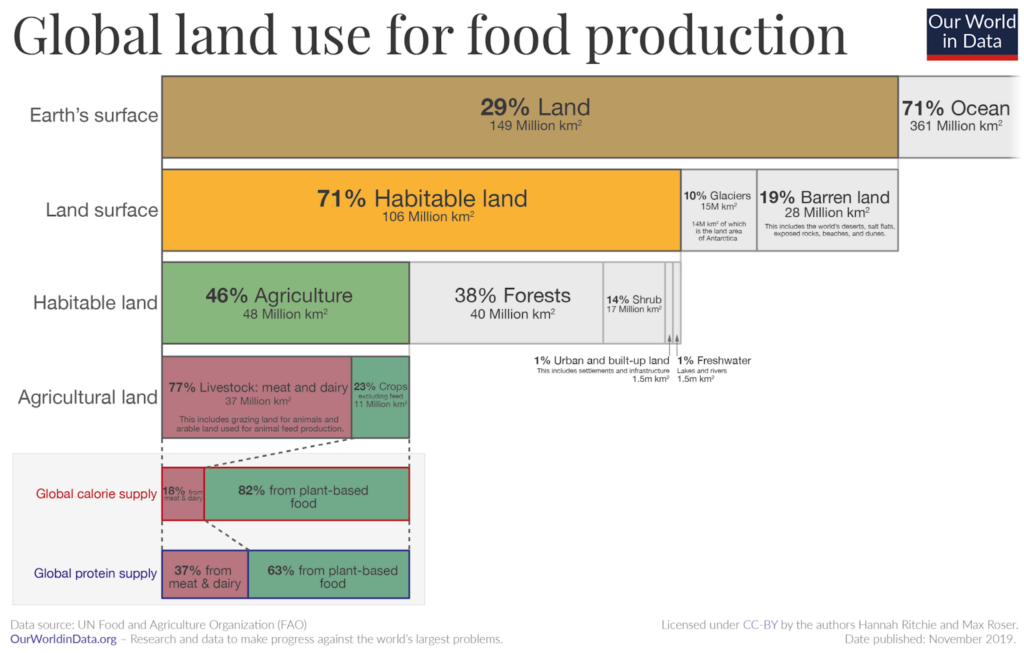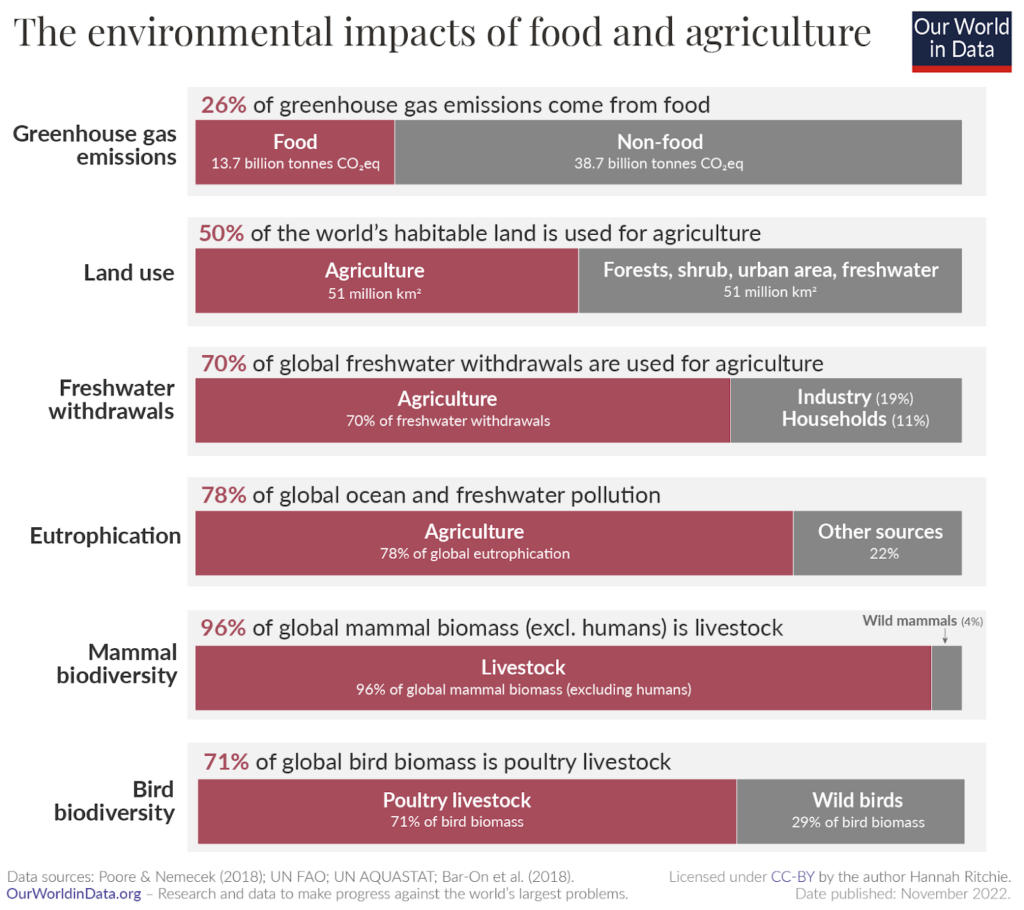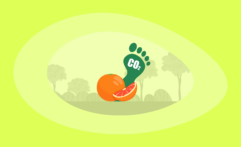The Environmental Impact of Pomegranates: From Farm to Table
Impactful Ninja is reader-supported. When you buy through links on our site, we may earn an affiliate commission.
Learn more
Learn more
.
Hey fellow impactful ninja ? You may have noticed that Impactful Ninja is all about providing helpful information to make a positive impact on the world and society. And that we love to link back to where we found all the information for each of our posts. Most of these links are informational-based for you to check out their primary sources with one click. But some of these links are so-called "affiliate links" to products that we recommend. First and foremost, because we believe that they add value to you. For example, when we wrote a post about the environmental impact of long showers, we came across an EPA recommendation to use WaterSense showerheads. So we linked to where you can find them. Or, for many of our posts, we also link to our favorite books on that topic so that you can get a much more holistic overview than one single blog post could provide. And when there is an affiliate program for these products, we sign up for it. For example, as Amazon Associates, we earn from qualifying purchases. First, and most importantly, we still only recommend products that we believe add value for you. When you buy something through one of our affiliate links, we may earn a small commission - but at no additional costs to you. And when you buy something through a link that is not an affiliate link, we won’t receive any commission but we’ll still be happy to have helped you. When we find products that we believe add value to you and the seller has an affiliate program, we sign up for it. When you buy something through one of our affiliate links, we may earn a small commission (at no extra costs to you). And at this point in time, all money is reinvested in sharing the most helpful content with you. This includes all operating costs for running this site and the content creation itself. You may have noticed by the way Impactful Ninja is operated that money is not the driving factor behind it. It is a passion project of mine and I love to share helpful information with you to make a positive impact on the world and society. However, it's a project in that I invest a lot of time and also quite some money. Eventually, my dream is to one day turn this passion project into my full-time job and provide even more helpful information. But that's still a long time to go. Stay impactful,Affiliate Disclosure
Why do we add these product links?
What do these affiliate links mean for you?
What do these affiliate links mean for us?
What does this mean for me personally?
![]()
Pomegranates are a booming global business, valued at around $24 billion. They are also a great source of antioxidants, fiber, and several vitamins. They are especially popular as juices. But pomegranates can have a negative environmental impact. There are many components of the pomegranate industry that cause serious damage to the environment. So we had to ask: What is the environmental impact of pomegranates?
Pomegranates have a very negative environmental impact. They use high amounts of pesticides, nitrogen fertilizers, and irrigation. They also occasionally use plastic packaging and have a low land yield.
In this article, we will examine the environmental impact of pomegranates from several different angles. We will go through the life-cycle of pomegranates, detailing their impact on the environment from growth to distribution to your plate to waste management. We will then compare the environmental impact of pomegranates to that of other fruits. And, finally, we’ll share some tips with you on how you can reduce your own environmental impact and offset your own carbon emissions – both for your personal life and pomegranate-related.
Here’s How We Assessed the Environmental Impact of Pomegranates
The Environmental Impact Assessment (EIA) is one of the ways we measure the potential environmental effects of our actions, like the consumption of pomegranates. It is a holistic assessment based on the environmental changes associated with our consumption. Those are changes in our environment that can have adverse effects on the air, land, water, fish, and wildlife or the inhabitants of the ecosystem.
“Environmental Impact: the effect that the activities of people and businesses have on the environment”
Cambridge Dictionary
Basically, all goods and services you buy – including pomegranates – leave an impact on our environment. When it comes to food in general, and pomegranates in specific, the following are key factors:
- Land requirements: Large parts of the world that were once covered by forests and wildlands are now used for agriculture. 10 million hectares of forest are destroyed annually and 50% of the world’s habitable land is now used for agriculture. This loss of natural habitat has been the main driver for reducing the world’s biodiversity.
- Water footprint: 70% of global freshwater is now used for agricultural purposes. By assessing the water footprint of a particular food, we can determine how our limited freshwater resources are being consumed and polluted.
- Pesticide and fertilizer usage: Pesticides and fertilizers provide a range of agricultural benefits. However, numerous studies link pesticides and fertilizers to serious effects on human health, along with disruptions to vital ecosystems and the spread of aquatic dead zones.
- Carbon footprint: The carbon footprint is one of the ways we measure the effects of our human-induced global climate change. Today, food production accounts for over a quarter (26%) of global greenhouse gas emissions.
- Waste generation: Food and its packaging account for almost 45% of the materials landfilled in the US alone. And packaging sent to landfills, especially when made from plastics, does not degrade quickly or, in some cases, at all.
To understand the overall environmental impact of pomegranates, we must assess each of their key factors. This Environmental Impact Assessment (EIA) is a tool originally developed to identify the environmental impacts of a project prior to decision-making and also helps us to evaluate the environmental impacts of pomegranates, from farm to table.
Here’s the Overall Environmental Impact of Pomegranates
Pomegranates have a very negative environmental impact. The main factors that contribute to this are their high pesticide use, irrigation requirements, use of nitrogen fertilizers, low land yield, and occasional use of plastic packaging. Their environmental impact is high compared to other fruits.
There are some positives when it comes to the environmental impact of pomegranates. For example, they are mainly grown domestically in the US, which reduces travel emissions. Whole pomegranates also typically don’t use plastic packaging. However, the majority of the pomegranate production process has a highly negative environmental impact.
So, let’s have a look at the environmental impact of each key factor of pomegranates!
| Key Assessment Factors | Environmental Impact |
| Land requirements for pomegranates | Pomegranates’ land requirements are high. They also use harmful agricultural techniques like multiple crop sequencing and monoculture farming, which negatively affect the environment. |
| Water footprint of pomegranates | Pomegranates have a moderate water requirement of 50 inches of water per year. However, because they don’t get enough rainfall where they are grown, they require significant amounts of irrigation. |
| Agrochemical usage for pomegranates | Pomegranates’ agrochemical use is very high. Their particular use of harmful nitrogen fertilizer means their environmental impact is very negative at this stage. |
| Carbon footprint of pomegranates | Pomegranates have a moderately high carbon footprint of 0.39kg (0.87lb) of CO2e per pound of pomegranates. This is mainly because of their high need for growth resources, pesticide use, refrigerated transportation, and low composting rates. |
| Waste generation of pomegranates | Pomegranate waste generation is high, depending on whether pomegranates are bought whole or shelled. Both types require either cardboard or plastic packaging so their waste disposal has a fairly negative environmental impact. |
These are the overall summaries, but there is a lot more to the story. In the next few sections, we will dive deeper into each stage to illustrate to you all the important aspects of pomegranates’ environmental impact.
What Are the Land Requirements for Pomegranates
Pomegranates’ land requirements are high. They also use harmful agricultural techniques like multiple crop sequencing and monoculture farming, which negatively affect the environment.

Growing pomegranates has a lot of variables that contribute to their environmental impact. The amount of land they use, the way in which they grow, and the amount of time they take to grow will all contribute to their environmental impact.
How do the land requirements of pomegranates impact their environmental footprint?
- What is the land usage of pomegranates: Pomegranates yield around 8 tons per hectare. This is one of the lowest land yields among fruits. For example, pears can yield 40-50 tons per hectare, and pineapples can yield up to 100 tons per hectare. Therefore, each pound of pomegranates will take up significantly more space than other fruits.
- Where and how are pomegranates grown: Pomegranates are mainly grown in the Mediterranean and Middle East, as well as Southeast Asia. Pomegranates grow on trees in orchards which sequester carbon. This can help them to offset some of their emissions and thus lessen their environmental impact. However, their ability to sequester carbon only lasts the first five years of growth. Once they reach maximum producing capacity, their carbon sequestering abilities tend to plateau. Therefore, though they do sequester some carbon early in life, it is not enough to lessen their environmental impact.
- How does the growing of pomegranates affect soil fertility and erosion: The particular method of farming that pomegranate farms often use is called multiple crop sequencing. This farming technique has been found to have negative effects on soil fertility, depleting nutrients. Pomegranates are also mainly grown in monocultures. Monocultures are terrible for biodiversity as they limit pollination, soil microbes, and other wildlife. Therefore, between multiple crop sequence growing and monoculture farming, pomegranates can have a very negative effect on soil.
- How does the pomegranates industry affect the loss of habitable land: Pomegranates have a very low land yield, so they will require more land to grow than other fruits. However, pomegranates are currently less popular than other fruits, producing 1.5 million tons annually, although their popularity is rising. In comparison, apples and oranges are evaluated at 76 million and 50 million tons per year, respectively. Therefore, while pomegranates are less efficient, their lower production rates mean they take up less space in the world than more popular fruits.
- How does the pomegranates industry affect wildlife and biodiversity: Monoculture farming is very harmful to wildlife and biodiversity. This is mainly because monocultures produce a very short flowering season, as opposed to the more balanced flowering season of polycultures. As a result, pollinators are starving for most of the year, which affects the whole food chain.
In short, pomegranate farming takes part in some damaging practices, such as monocultures and multiple crop sequencing. This combined with their low land yield, means they have a significantly negative environmental impact at this stage.
What Is the Water Footprint of Pomegranates
Pomegranates have a moderate water requirement of 50 inches of water per year. However, because they don’t get enough rainfall in their area, they require significant amounts of irrigation.
Water usage is one of the most important factors in the environmental impact of a fruit. The amount of water used, as well as the way they affect the water sources around them, are all major contributing factors. Here, we will look at these different angles to pomegranates’ water impact.
How does the water footprint of pomegranates impact their environmental footprint?
- What is the overall water usage of pomegranates: Pomegranates need around 50 inches of water per year. This is a fairly average water requirement compared to other fruits. For example, cherries only need 35 inches of water a year, but figs need up to 75 inches per year.
- What is the green water footprint of pomegranates: The green water footprint is the amount of water from precipitation stored in the soil and used by plants for growth. The vast majority of US pomegranates come from California. However, California only gets a meager 22 inches of rain per year, which doesn’t cover pomegranates’ requirements. In California, the majority of rainfall in the area will be used by pomegranate crops, and so they have a high green water footprint.
- What is the blue water footprint of pomegranates: The blue water footprint is the amount of water sourced from surface (such as rivers or lakes) or groundwater resources. Since pomegranates’ water requirements aren’t covered by California’s average rainfall, they will need significant irrigation. Therefore, their blue water footprint is high.
- What is the gray water footprint of pomegranates: The gray water footprint is the amount of freshwater required to clean up water pollution to meet certain quality standards. Essentially, it’s the amount of water needed to make polluted water clean enough to be safe and healthy for humans and the environment. Pomegranates have fairly high pesticide usage. This means that a significant amount of water will be needed to clear up all their pesticide residue.
- How does the pomegranates industry affect freshwater and ocean pollution: Irrigation can be very harmful to waterways. This is mainly because it can cause imbalances in the groundwater and destabilize salination. Pesticides and other agrochemicals are also damaging to the environment, as they get into waterways and harm aquatic life. As a result, pomegranates have a very negative impact on freshwater.
In short, pomegranates are very demanding on water resources and pollute the waterways significantly through their use of irrigation and pesticides.
What Is the Agrochemical Usage for Pomegranates
Pomegranates’ agrochemical use is very high. Their particular use of the harmful nitrogen fertilizer means their environmental impact is very negative at this stage.
Pesticides and fertilizers are agrochemicals that can have a significant impact on the environment. They both require resources to create as well as have effects on the life around them. Here, we will look at how pomegranates’ pesticide and fertilizer rates affect their environmental impact.
How does the agrochemical usage of pomegranates impact their environmental footprint?
- What is the pesticide usage of pomegranates: Pomegranates have high pesticide rates. Pesticides have a very negative environmental impact. They not only have adverse effects on groundwater, but they can also impact wildlife, insect populations, and soil microbes. Therefore, through their high pesticide usage, pomegranates can damage the environment in a number of ways.
- What is the fertilizer usage of pomegranates: Pomegranates primarily use nitrogen fertilizers. Nitrogen fertilizer has been found to be one of the most polluting fertilizers out there. It is particularly known for releasing nitrous oxide and damaging waterways by promoting invasive algae growth.
- Are there any known issues connected to the agrochemical usage for pomegranates: Pomegranates’ heavy use of pesticides has been connected with ecological damage, as well as harm to human health. Nitrogen fertilizer is also very harmful to human health through its emissions and water pollution.
In short, pomegranates’ heavy use of pesticides and nitrogen fertilizer means that it causes a whole slew of damages to waterways, wildlife, soil, and even human health.
What Is the Carbon Footprint of Pomegranates
Pomegranates have a moderately high carbon footprint of 0.39kg (0.87lb) of CO2e per pound of pomegranates. This is mainly because of their high need for growth resources, pesticide use, refrigerated transportation, and low composting rates.

Carbon footprint is one aspect of the overall environmental impact of a fruit. It essentially measures how much carbon or other greenhouse gasses the production of pomegranates emits into the atmosphere. Emissions from product manufacturing, irrigation, transportation fuel, and landfills all add up to create the overall carbon footprint of a fruit. Let’s see how the carbon footprint of pomegranates breaks down and contributes to their environmental impact.
How does the carbon footprint of pomegranates impact their environmental footprint?
- What is the overall carbon footprint of pomegranates: The overall carbon footprint of pomegranates is 0.39kg (0.87lb) of CO2e per pound of pomegranates. This means that for every pound of pomegranates produced, 0.39kg of carbon is released into the atmosphere. This is a fairly high carbon footprint compared to other fruits.
- What are the main contributors to the carbon footprint of pomegranates: The main factors that contribute to pomegranates’ carbon footprint are high land use, irrigation requirements, pesticide use, refrigerated trucking, and low composting rates.
- Which life-cycle stage of pomegranates has the highest carbon footprint: The stage that contributes the most to pomegranates’ carbon footprint is the growth stage. This is because they take a long time to grow, don’t use land economically, and have high irrigation and pesticide rates.
In short, pomegranates have a fairly high carbon footprint, mainly due to the high resources needed during their growing period.
What Is the Waste Generation of Pomegranates
Pomegranate waste generation is high, depending on whether pomegranates are bought whole or shelled. Both types require either cardboard or plastic packaging so their waste disposal has a fairly negative environmental impact.
When fruit waste, either packaging or organic materials, is disposed of, it can have a major impact on the environment. Whether it’s damaging wildlife, getting into oceans, emitting methane, or dissolving into microplastics that contaminate groundwater, all these materials have their part to play. In this section, we will look at how pomegranates’ waste affects the environment.
How does the waste generation of pomegranates impact their environmental footprint?
- What is the packaging of pomegranates: Whole pomegranates are typically packed in wholesale cardboard boxes. Whereas, shelled pomegranate seeds typically come in plastic clamshells. Both plastic and cardboard have devastating environmental effects. Therefore, simply the production of pomegranate packaging has a negative impact on the environment.
- How is the packaging of pomegranates disposed of: Both plastic and cardboard are usually recyclable. However, their real-world recycling rates are vastly different. Cardboard has a very high recycling rate of 89%, whereas plastic has a very low recycling rate of 9%. This means that the majority of shelled pomegranate packaging is ending up in landfills. Landfills are incredibly damaging to the environment, and plastic in particular can create microplastics, which end up in groundwater and food.
- How are pomegranates disposed of: Pomegranates have thick peels that are not generally eaten. They can be composted, but unfortunately, only 4% of food waste is actually composted, leaving the other 96% for landfills. Besides the general environmental impact of landfills, food waste in landfills releases methane, a harmful greenhouse gas. Therefore, pomegranate food waste has a significantly negative impact on the environment.
In short, pomegranate packaging and food waste is a major contributor to their negative environmental impact. This is mainly because of low composting rates and low plastic recycling rates.
What Have Been Historical Environmental Issues Connected to the Pomegranate Industry
The pomegranate industry has historically had a very negative impact on the environment. This has occurred through increasing land use, pesticides, and nitrogen fertilizers.
All fruits have had a complex road toward global distribution. They originate in one part of the world and often travel far to end up in your local supermarket. From farm to table, some of our favorite fruits have racked up some serious environmental damage along the way. Whether it’s deforestation to meet demand, water pollution, or disruption of wildlife, most fruits have left a path of destruction. Let’s see how pomegranates have fared throughout history.
What have been the key environmental issues of the pomegranates industry?
- How much land has been lost because of pomegranate production: Because pomegranate production is generally lower than other fruits, they haven’t had as big an impact on global deforestation. However, their industry is growing, which means that they are having an ever-increasing impact on land because they need to clear more land to make ways for new pomegranate orchards.
- Which wildlife species have been negatively impacted or displaced because of pomegranate production: Pomegranates have historically used a high amount of pesticides compared to other fruits. This means that they have had an adverse effect on wildlife over the years. Many wildlife species in California, where most pomegranates are grown, have been negatively affected by pesticides. These species include the bald eagle, great-horned owl, black bear, and the coyote.
- Have water sources and soil been contaminated because of pomegranate production: Pomegranates have historically used a significant amount of nitrogen fertilizer. In California, nitrogen fertilizer has had a particularly damaging effect on groundwater and other water sources.
In short, pomegranates’ continued use of nitrogen fertilizers and pesticides, as well as their ever-increasing production, has caused significant environmental damage, especially in California.
What Is the Overall Environmental Impact of Food and Agriculture
Food production in general has a high environmental impact. Everything from the amount of land used to the energy involved in irrigation to its effect on plant and animal biodiversity can be a factor in this. In the chart below, you can see how food production is one of the biggest influences on these areas of the environment.

Agriculture alone accounts for over a quarter of global greenhouse gas emissions, while using half of the world’s habitable land and 70% of the global freshwater withdrawals. Agriculture also causes 78% of the global ocean and freshwater pollution.
Livestock accounts for the vast majority of non-human mammal and bird biomass. Mammal livestock outweighs wild mammals by a factor of 15-to-1, and poultry livestock outweighs wild birds by a factor of more than 3-to-1.
These statistics highlight the need for sustainable and responsible practices in food production to reduce its impact on the environment. And the need for us to shift toward more environmentally-friendly foods.
How Can You Reduce Your Environmental Impact and Offset Your Personal Carbon Footprint
There are a few things you can do to mitigate some of the negative environmental effects of consuming pomegranates, while still enjoying them. You can also consider offsetting your personal and pomegranate-related carbon emissions, which work to remove carbon emissions elsewhere that are then attributed to you. Here, we will walk you through how to accomplish both of these things.
How Can You Reduce Your Environmental Impact When Shopping for Pomegranates
In this section, we give you a short list of ways you can reduce the negative environmental effects of pomegranates, based on those parts of the life-cycle of pomegranates that would otherwise most negatively impact the environment:
- Buy organic pomegranates: Pesticides are some of the biggest contributors to pomegranates’ environmental damages. Organic farms make the commitment to avoid using chemicals, including pesticides. Thus, making the effort to buy organic pomegranates will help you to reduce some of the more negative aspects of pesticides’ environmental impact.
- Compost your pomegranate waste: Pomegranate peels ending up in landfills can cause environmental havoc. If you make the effort to compost your pomegranate peels then you will be greatly reducing the space they take up in landfills, as well as the methane emitted from them. If you can’t compost through your city’s waste management system, then you can consider creating your own compost!
- Recycle any boxes or plastic: If your pomegranates come in a cardboard box, or if you buy shelled pomegranates in a plastic container, then you should try your best to recycle them. By doing this, you will be keeping them out of the landfills, and in plastics’ case, prevent the pollution caused by microplastics.
Following some of these methods can really help you to cut down on your environmental impact of eating pomegranates. None of these will completely eradicate these negative impacts, since there are always effects that may be outside of your control. But some reduction is always better than nothing!
Which Organizations Can You Support to Help Alleviate Your Environmental Impact
While pomegranates can cause a wide range of environmental damage, there are also some organizations that help you reduce parts of your impact that would otherwise be outside of your control. These organizations are working hard to prevent and reverse damage to the environment caused by industries like pomegranate agriculture.
In the table below are some of the best environmental charities that work in the areas where pomegranates production has affected the environment – and beyond:
Though it is helpful to reduce the environmental impact of your personal pomegranate consumption, supporting these organizations takes your positive impact a step further. You will be reaching far beyond your own consumption impacts and helping to build a better world for everyone!
How Can You Offset Your Personal Carbon Footprint
The carbon footprint is a key part of your environmental impact. And it is one of the ways we measure the effects of our human-induced global climate change. Yes, even from eating pomegranates!
“Carbon footprint: the amount of greenhouse gasses and specifically carbon dioxide emitted by something (such as a person’s activities or a product’s manufacture and transport) during a given period”
Merriam Webster
Basically, it is the amount of carbon emitted by you as an individual or an organization providing you with goods and services – including pomegranates:
- This includes GHG emissions from producing the products that we use and foods that we eat (e.g., power plants, factories or farms, and landfills)
- GHG emissions from fuel that we burn directly or indirectly (e.g., logistics and transportation, cooling or heating facilities),
- as well as the GHG emissions attributed to how we consume these products and foods.

Carbon offsets are reductions in carbon emissions that are used to compensate for carbon emissions occurring elsewhere – for example for the carbon emissions that are associated with pomegranates. They are measured in tons of CO2 equivalents and are bought and sold through international brokers, online retailers, and trading platforms on what is known as the global carbon offset market.
“Carbon Offset: a way for a company or person to reduce the level of carbon dioxide for which they are responsible by paying money to a company that works to reduce the total amount produced in the world, for example by planting trees”
Oxford Dictionary
In terms of pomegranates – and indeed all food types – there will always be a carbon footprint, because of the resources it takes to get your food from farms to the place where you’ll eventually eat them. And while there are ways to reduce your carbon footprint when shopping for pomegranates, carbon offsets would be a way to reduce your CO2e emissions all the way down to net zero (or even to become climate positive).
However, when you purchase carbon offsets, it’s important that they actually make a difference in offsetting (aka reducing) total carbon emissions. To achieve that, the following are key criteria:
- Carbon offset projects have to be effective (different projects have different effectiveness rates)
- Carbon offset projects have to be additional
- Carbon offset projects have to be permanent
- The claims from carbon offset projects have to be verifiable
To find the best carbon offsets for you personally, check out our full guide on the best carbon offsets for individuals, where you’ll also learn more about how these carbon offset projects work, what their respective offsetting costs are, and what your best way would be to offset your own carbon emissions.
Final Thoughts
Pomegranates have a long way to go before they can have a positive environmental impact. They require so much irrigation, use copious amounts of pesticides, and are fertilized using one of the most harmful chemicals to the environment. However, by trying your best to reduce aspects of your pomegranate consumption, and supporting charities that aim to combat some of the more damaging aspects of pomegranate agriculture!
Stay impactful,

Sources
- Global News Wire: Global Pomegranate Market
- Healthline: 12 Proven Benefits of Pomegranate
- Healthy Nibbles and Bits: How to Make Pomegranate Juice
- UN Environment Programme: Environmental Impact Assessment and Strategic Environmental Assessment: Towards an Integrated Approach
- Our World in Data: The environmental impacts of food and agriculture
- Our World in Data: Global land use for food production
- World Health Organization: Preventing disease through healthy environments: a global assessment of the burden of disease from environmental risks
- ScienceDirect (Biological Conservation): Worldwide decline of the entomofauna: A review of its drivers
- EPA: The Sources and Solutions: Agriculture
- EPA: Reducing Food Waste and Packaging
- FoodPrint: The Environmental Impact of Food Packaging
- Jacksonville: Care and Feeding of a Pomegranate Tree
- Impactful Ninja: What is the Carbon Footprint of Pomegranates
- Amra Farms: Pomegranate Farming
- Impactful Ninja: What is the Carbon Footprint of Pears
- Impactful Ninja: What is the Carbon Footprint of Pineapples
- Garden Eco: Where Do Pomegranates Grow
- Agrifarming: Pomegranate Farming
- Green Matters: How Do Carbon Emissions Affect the Environment
- Springer: Carbon Sequestration Pomegranate
- Science Direct: Agronomic Performance
- IJHSR: Pomegranate: The Cash Crop of India
- EOS: Monoculture Farming
- Global Science Books: Global Scenario of Pomegranate
- Agri Benchmark: World Apple Production
- World Atlas: Top Orange Producing Countries
- USDA: Carbon Footprint of Pomegranate
- EOS: Monoculture Farming Explained
- Gardening Knowhow: How to Water a Cherry Tree
- Gardening Knowhow: Water Requirements for Fig Trees
- Water Footprint Network: What Is a Water Footprint?
- CANR: Plant Science at Your Dinner Table: Pomegranates
- Best Places: California
- Telegraph India: UK Sees Health Risk in Indian Pomegranates
- National Geographic: Environmental Impacts of Agricultural Modification
- USGS: Pesticides in Groundwater
- Science Direct: Towards Understanding the Impact of Pesticides on Groundwater
- USGS: Pesticides in Groundwater
- GOV.BC: Environmental Protection and Pesticides
- Gardening Knowhow: Fertilizer for Pomegranates
- Mitsui: Reducing the Environmental Impact of Chemical Fertilizers
- EPA: The Issue With Nitrogen Fertilizer
- Farmer.gov: Pomegranate
- Antonio Marco: Pomegranate Storage and Transport
- EPA: Reducing the Impact of Wasted Food
- Green Harvest: Pomegranate Growing Information
- SN Applied Sciences Journal: Worldwide pesticide usage and its impacts on ecosystem
- Post Harvest: Pomegranate Varieties, Packing, and Nutrition
- Colostate: Pomegranates
- Biological Diversity: The Plastic Production Problem
- TRVST: Environmental Impact of Cardboard
- Also Known As: 12 Interesting Facts About Packaging Waste and Disposal
- Colorado: The Hidden Damage of Landfills
- UNEP: How Tiny Plastic Particles Are Polluting Our Soil
- BBC: How Plastic is Getting Into Our Food
- GOV.BC: Waste Management
- UNECE: Sustainable Development
- GOV.BC: Environmental Protection and Pesticides
- UCANR: Investigation of Wildlife Losses From Pesticides
- CDFA: Nitrogen Fertilizer
- Our World in Data: Global greenhouse gas emissions from food production
- Our World in Data: The environmental impacts of food and agriculture
- Gardeners World: How to Make Compost
- Impactful Ninja: Best charities that fight to protect our environment
- Impactful Ninja: Best charities for reforestation
- Impactful Ninja: Best wildlife conservation charities
- Impactful Ninja: Best charities for protecting the Amazon rainforest
- Impactful Ninja: Best charities that protect our national parks
- Impactful Ninja: Best charities that fight for clean water
- Impactful Ninja: Best charities that help conserve our rivers
- Impactful Ninja: Best charities to save our oceans
- Impactful Ninja: Best charities that help farmers
- Impactful Ninja: Best charities for helping farm animals
- Impactful Ninja: Best charities for climate change
- Impactful Ninja: Best carbon offsets for individuals
- Impactful Ninja: Best charities that fight to reduce food waste
- Impactful Ninja: Best charities that fight to end plastic pollution
- Our World in Data: Emissions from food alone would take us past 1.5°C or 2°C this century
- Impactful Ninja: Why Is a Carbon Footprint Bad for the Environment
- Impactful Ninja: Best Carbon Offsets for Individuals




